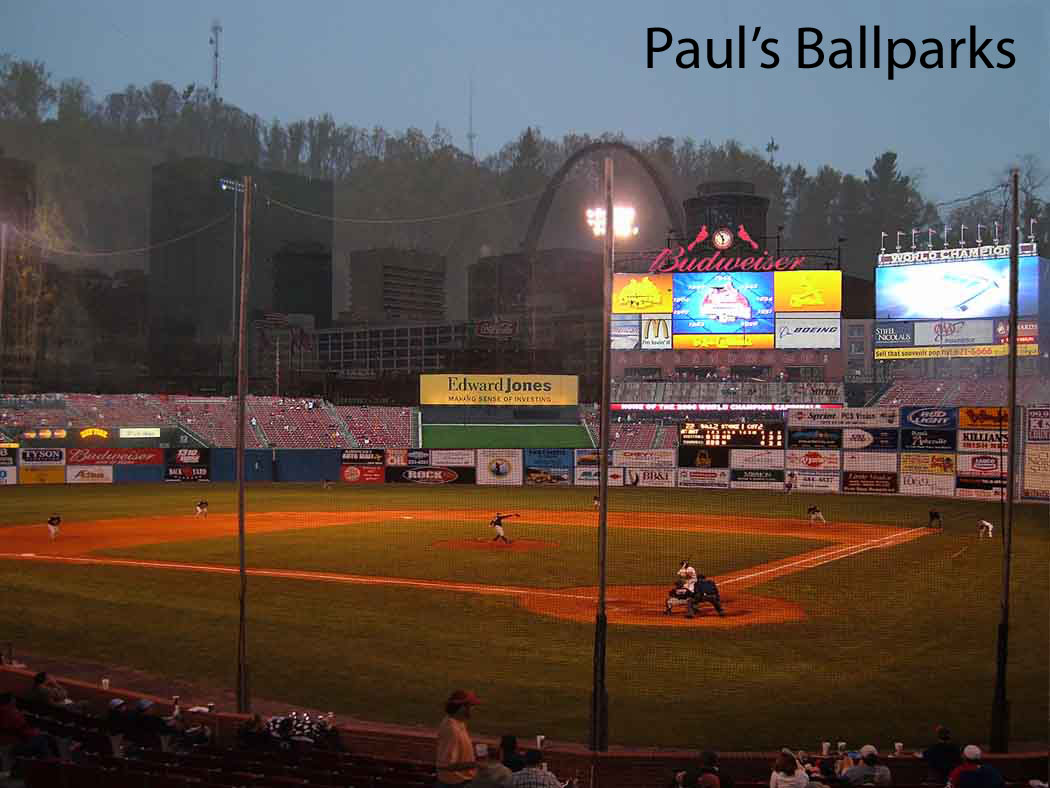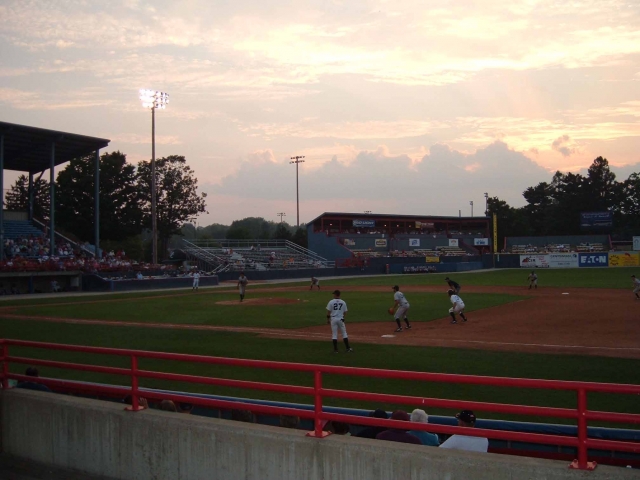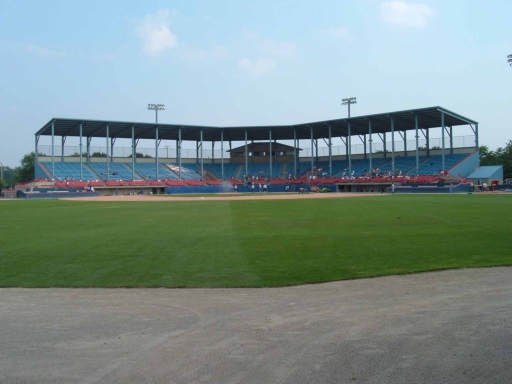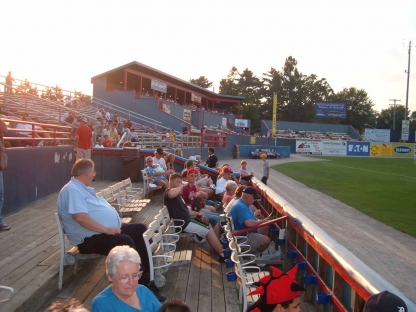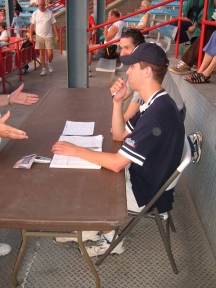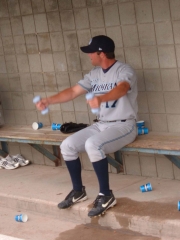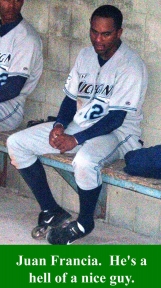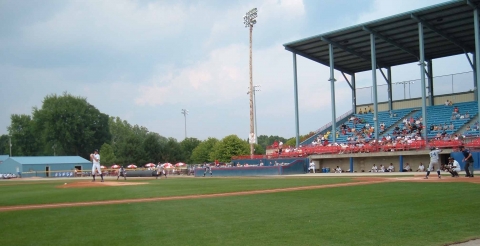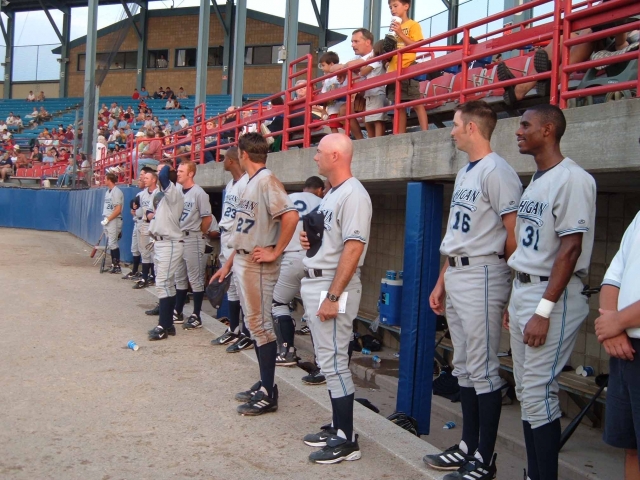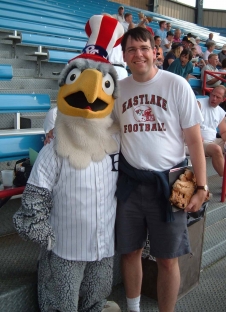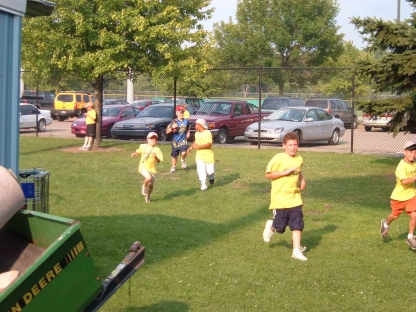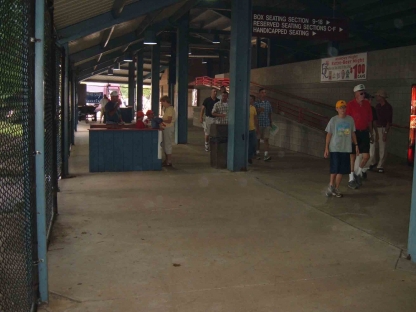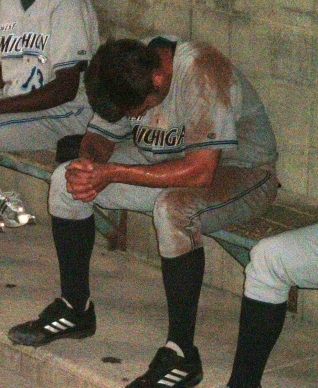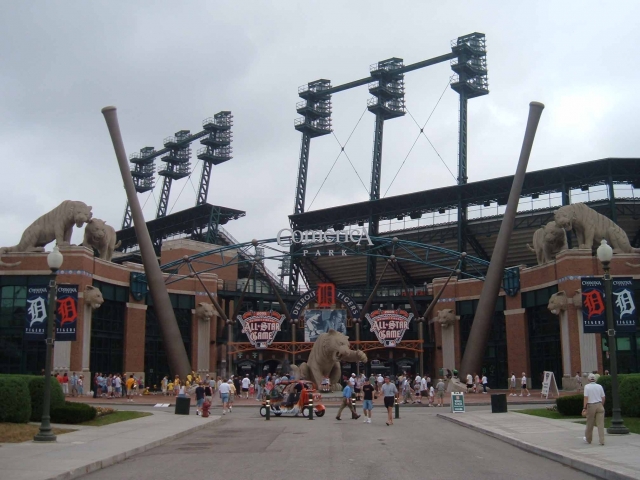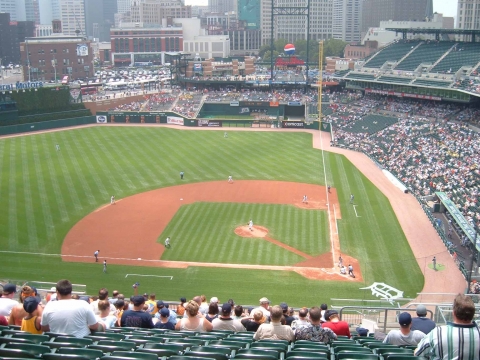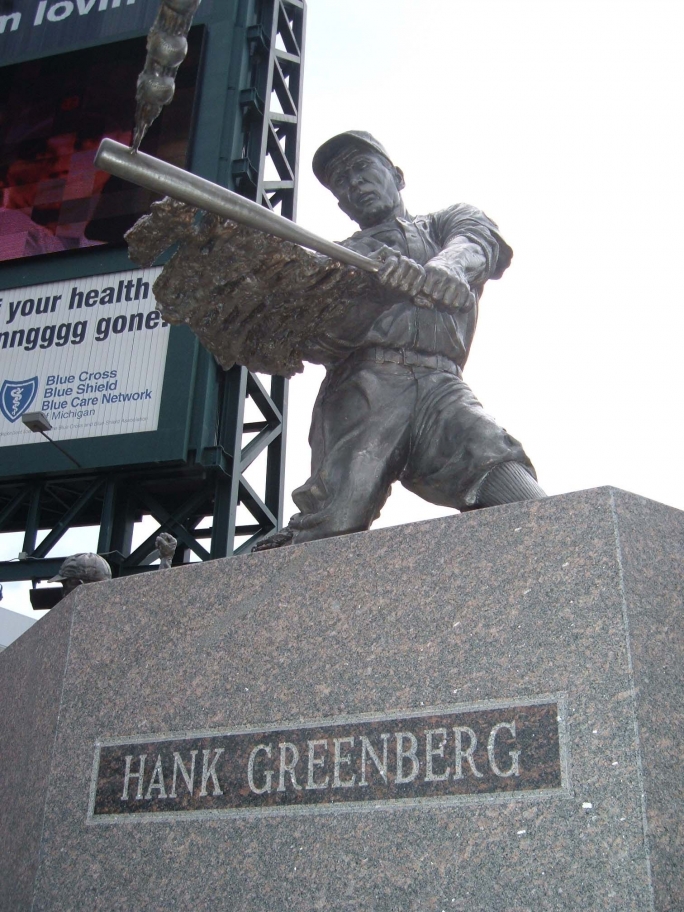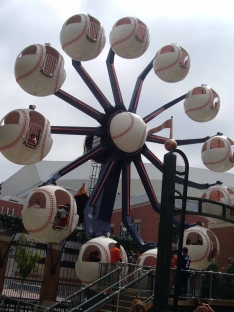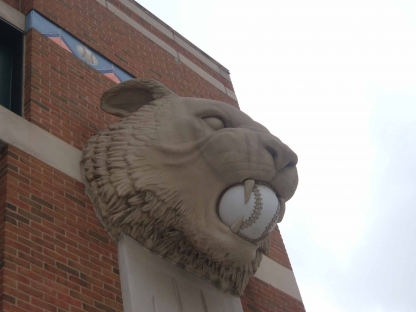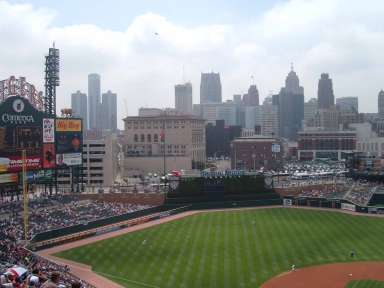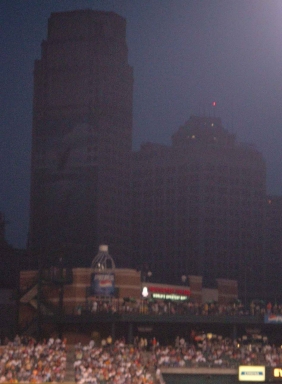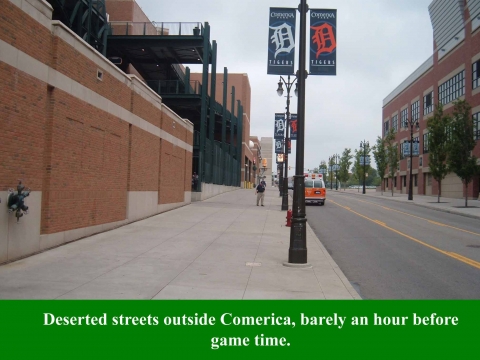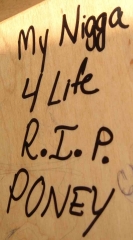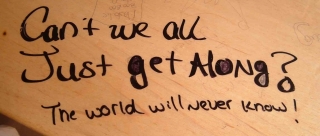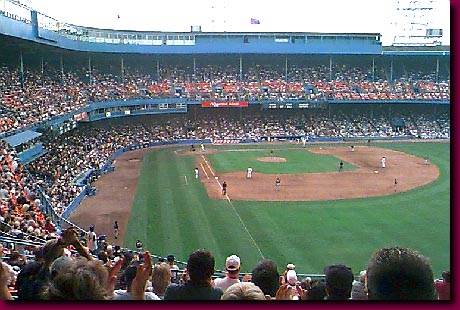C.O. Brown Stadium, Battle Creek, MICHIGAN
Number of states: 7
States to go: 43
Number of games: 1
First and last game: July 20, 2004 (Battle Creek Yankees 3, West Michigan Whitecaps 2, 10 innings)
C.O. Brown Stadium is no longer in use for the affiliated minors as of the 2007 season.(Click on any image to see a larger version.)
Singing buddy Kristin and I found our way to Cereal City after experiencing the annoying shortcomings of South Bend and the always fantastic Wrigley Field. Since I had no experience with Battle Creek other than driving through it on I-94 a few times (sometimes it smells like Corn Flakes, other times like Froot Loops), I had no real expectations for the evening. What I got was quite a memorable ballgame, an extremely quirky ballpark, and a sense that I was a part of the dugout for the West Michigan Whitecaps.
The park’s location is fairly typical for single-A: it’s a part of a recreational complex, just the largest of about a half dozen fields on the site. The cool part about this is that, at least on the night I went, there were other games to be seen on site. If Kristin and I had arrived earlier, we could have sat in on either of two other baseball games taking place (it may have been American Legion or AAU ball). It was here that I secured my only foul ball of the whole trip, but alas, it was not at the Yankees/Whitecaps game…it was one launched into the parking lot from one of the other games. I retrieved it and dutifully tossed it back.
I can’t for the life of me figure out how C.O. Brown Stadium came to be shaped exactly as it is. The largest block of seating is behind home plate, but there’s an almost-as-big block which hooks around the left-field foul pole. My best guess (indeed, my only guess) is that the older-looking seating area by the foul pole was, at one time, the only block of seats in the ballpark, and that home plate used to be over there. My theory then has the larger block built later on, and home plate moving but all the seating remaining. A friendly usher was unable to help me solve this conundrum, and I still can’t figure out why the ballpark looks that way. Quirky? Yes. Charming? That’s in the eye of the beholder.
Another quirky feature of the ballpark adds loads to its charm, however. Just past each dugout is a box of seats that juts out four or five rows beyond the dugout and towards the field. Kristin and I had seats on the inside edge of that section, second row. That means that, by looking over our right shoulders, we were able to look directly into the visitors’ dugout. Any sense of privacy those players hoped to have was shot! I looked as players lifted barbells, chatted, high-fived, and watched the game. It made it very easy to root for West Michigan on that day.
Besides, just out of principle, I can’t root for any team nicknamed the “Yankees.” I’m annoyed that the team has this name. Battle Creek’s name was just changed in 2003, from the locally appropriate (and interesting) “Battle Cats.” Does George Steinbrenner think that everyone really wants to be like him? Worse yet, after the Yankee victory, the loudspeakers played “New York, New York.” Gimme a break! We’re not in New York, even if it’s what the players are striving for. You know the line “If I can make it there, I’ll make it anywhere?” Well, the players have to make it in Battle Creek first. Lay off that song, or at least relegate it to pregame somewhere.
As I meandered through the ballpark before the game, I saw a scoresheet on a table behind home plate on the main walkway. Would the Yankees really put their official scorer out there with the people? I was astonished. Later, I found out that this was not at all true–but instead was part of what I think is a fantastic promotion that balances my desire for promotions at the low-minor level without the concern that those promotions will interfere with the baseball. Spectators were given Bingo cards upon entry to the stadium with various possible outcomes on them, such as “Matt Carson walks” or “Nick Walsh doubles.” This means that fans must keep track of the game to fill out their bingo cards. The scorebook behind home plate was not the official scorekeeper, but was the Yankees’ worker keeping score–the guy the winner takes the bingo card to as soon as he/she has a bingo. I had never seen this before, and was quite impressed with the idea.
At the end of pregame warmups, Whitecap Juan Francia got on my good side by delivering a baseball to a youngster next to me. What a stud–I hope he rises through the organization. He went 1-for-4 with a walk and a stolen base, as well as some flashy defensive play. But I’ll always remember him first for being a nice guy.
It was church night in Battle Creek, so I had to be on my best behavior. According to the Yankees, 361 of the 1,574 in attendance were a part of ten or twenty church groups that were in attendance. A chorister from one of the churches sang the National Anthem and bungled it badly–he started in a key so breathtakingly high that I turned to fellow singer Kristin and whispered “I’ll hate to hear ‘the rockets’ red glare.'” Sure enough, when he got there, he had to drop down an octave. Later, he sort of made up a melody for “land of the free” to dodge that high note as well. Singers–if you are to sing the National Anthem a cappella, I implore you to do the following: for a couple of minutes before you begin, sing “Oh say can you see” and “And the rockets’ red glare” back to back repeatedly. “Say” and “red glare” are the lowest and highest notes you’ll have to sing, unless you choose to go up the fourth on “land of the free” later on. This will prepare you for the anthem and avoid the situation this man found himself in. It always worked for me.
I don’t know if this was planned, but after the sixth inning, they gave the anthem singer another shot at the mike, this time to sing “How Great Thou Art.” I guess this was to celebrate church night. This led to a bizarre situation on the field and in both dugouts. How does one respond to the singing of a religious hymn during a game? I admit, when the guy started singing, I stood and removed my cap…but as soon as I realized he was singing “How Great Thou Art” rather than “God Bless America” or another patriotic song, it occurred to me that it might not be appropriate to have my hat over my heart and standing at attention to the flag. This is not the national anthem. I passionately love my God and my country, but I passionately love them separately. Mixing them by observing the flag while singing a religious hymn felt wrong to me. However, I’d want to be respectful by standing in silence, just as I would stand in silence for a sacred song for any religion. So I was at a bit of a loss for what to do, and figured it would be worse for the players. Do the players look at the flag, stand reverently, or just go about their business? A quick look over my shoulder, however, revealed that West Michigan manager Matt Walbeck (who, until and including the previous season, had been a major league player) had his hat over his heart, and had beckoned his team to join him on the top of the dugout steps, which they did:
Seconds later, however, I think Walbeck realized that this wasn’t “America the Beautiful,” because by the time the singer got to “My savior God to thee,” Walbeck had run out of the dugout to his third-base coaching position, where he prepared for the inning. The Whitecaps’ players, at least a couple of whom must be Jewish or Muslim or agnostic or atheist, all of whom had until seconds earlier had been standing in reverent silence, had headed to the bat racks and benches, perhaps wondering what the heck had happened. And Wilton Reynolds, the designated hitter, had clearly realized the bizarreness of the situation, because he actually was doubled over in laughter. I made eye contact with him–I thought the whole thing was funny too. (Looking at the picture above, it looks like Vince Blue, #31, also senses something is awry.)
On the whole, this was a nice way to spend a muggy Michigan night–surrounded by nice people enjoying a ballgame at an old park. This also turned out to be one of the best minor league ballgames I’ve ever had the pleasure of watching. I’ll tell you about that under “Baseball stuff” below.
BALLPARK SCORE:
Regional feel: 6.5/10
Reasonable, with big Midwestern trees beyond the outfield wall and massive Midwestern clouds, but nothing really to denote Michigan or Battle Creek. I couldn’t even smell the Froot Loops until I was on my way out of town.
Charm: 4.5/5
Sure. Quirkiness and fans so close to the action that kids talked to the bullpen catcher as he warmed up pitchers.
Spectacle: 5/5
Excellent here. Understated and persistent–frequent between-innings action and the Bingo game tied right in with the baseball.
Team mascot/name: 2/5
The name change to Yankees was tragic, as the old “Battle Cats” paraphernalia on sale for half price was one of the saddest things I’ve seen. I hope Steinbrenner helped defray the costs. The mascot himself is Doodle–apparently a youngster or a very short individual. I like the name Doodle (get it?) a lot.
Aesthetics: 3/5
Sweet on the outside, but not too attractive on the inside (see below).
Pavilion area: 2.5/5
There was an area where kids were playing pickle, but it was far too small. Mostly, it was just prison-like cement.
Scoreability: 3/5
Numbers and names readily available in the pavilion, but by the seventh inning, the names they had on the scoreboard didn’t at all match the actual people at bat. It’s like the scoreboard people gave up. Good for a while, though.
Fans: 3.5/5
The church people were very nice in the conservative Midwestern way (and I mean that affectionately–not at all sarcastically or disparagingly). A few drunken louts nearby hurt the score.
Intangibles: 4.5/5
A great game where I felt like I was chatting with the players. Fun night.
TOTAL: 34.5/50
BASEBALL STUFF I’VE SEEN HERE:
What a game! Mr. Walbeck has a little work to do in the managerial department, I’m afraid. The game’s star was Whitecap starter Virgil Vasquez, who cruised through eight innings of four-hit shutout ball. I was surprised to see him come back out for the ninth inning. Don’t they have pitch counts at A-level ball? Walbeck had a reliever, Eulogio de la Cruz, warmed up, and Vasquez had thrown quite a few pitches. Still, he struck out Matt Carson to start the inning, and things looked good for West Michigan. When third baseman Kody Kirkland kicked Erold Andrus’ liner, there was one on and one out, and I was thinking that one more baserunner and would bring out Walbeck with the hook. Bryce Kartler singled. Vasquez stayed on. A popout brought it to two on and two outs…then a laboring Vasquez walked John Urick. SURELY, I thought, this has to be it for Vasquez…he’s had a fine game, now de la Cruz can nail it down, right? Nope. Walbeck stuck with Vasquez. It turned out to be a bad move, as Tommy Rojas singled to tie the game with two unearned runs. Only then, too late, did Walbeck relieve Vasquez.
De la Cruz got out of the inning, but Battle Creek won in the tenth on Andrus’ RBI single. An angry Kody Kirkland, whose error made all of this possible, violently kicked a plastic cooler in the dugout on his way back to the clubhouse after the game.
Also, Garth McKinney homered for the Whitecaps. Party on, Garth. (I bet he’s never heard that one before! Man, it just occurs to me that Garth would have been around 10 at the height of Wayne’s World…what a bummer of a time to be 10 and named Garth.)
(Written August 2004.)